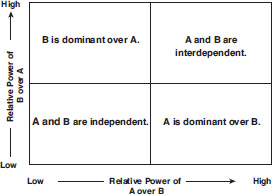Activity 23
Power/dependency profiling
Overview
The power/dependency model charts the four potential power structures between any two parties in a commercial relationship. It recognises that both parties have elements that give them power and that therefore these respective positions need to be charted against each other.
The authors refer to these elements as ‘critical assets’, but they could equally include know-how, superior capabilities, market position and intellectual property.
The authors of this model claim that the power of one party over another is based on the relative scarcity and utility of each party’s resources. For example, a supplier might have access to a specific raw material or design patent, which gives it relative power over a buyer.
Similarly, the buyer might control distribution to a specific market or might have negotiated a restricted covenant on a supplier’s business elsewhere.
The model considers the relative strength of each party’s power over the other and indicates which of the four different power structures applies in any given circumstance.
Elements
The four quadrants of the power/dependency matrix can be discussed as follows:
- B is dominant over A – Party B has dominance because Party A has little or no power over it. Party B can therefore command superior terms. Typically, this could occur when a supplier operates a monopolistic market and the buyer has no practical or effective alternative.
- A and B are independent – Neither party has any power over the other. This typically might be the case in low-value spot purchases within a competitive market. As such, the parties can operate with relative independence to each other.
- A is dominant over B – Party A has dominance because Party B has little or no power over it. Party A can therefore command superior terms. Typically, this could occur when a supplier is dependent on a buyer for ongoing business.
- A and B are interdependent – This is the situation where both parties are relatively powerful. For example, there could be contractual lock-in, intellectual property protection, restricted market alternatives and so on. As these scenarios apply to both parties, they become relatively interdependent on each other.
So what?
It is essential for buyers to understand the structure of power in any given supply-market or commercial relationship. By understanding this, they are able to determine the most appropriate category development strategy, negotiation approach and commercial terms. Put simply, without understanding the structure of power, a buyer risks being commercially ineffective.
Business relationships are becoming increasingly complex, and therefore power dimensions – and more particularly how each party uses them – are important to ensure purchasers are getting the best value for their organisations.
Category management application
- Can be used to analyse existing supplier relationships and how to manage categories of spend most effectively
- Helps with understanding supply markets prior to sourcing from them
Limitations
The authors of the model provide detailed academic descriptions of different power structures in play. However, they do not provide a succinct definition of ‘critical assets’, nor do they detail the way in which you can practically determine the relative power between the parties. As a result, although there is a lot of academic validity in the model, it remains difficult to apply in practice.
Furthermore, the model does not inform you what you should do in each of the four situations – and this is an essential omission in its practical application.
Template
The following template can be used to map the power and dependency structure of an organisation’s relationships with key suppliers within any given category:
- Template 23: Power/dependency profiling
